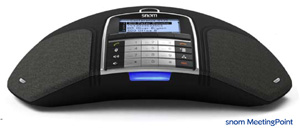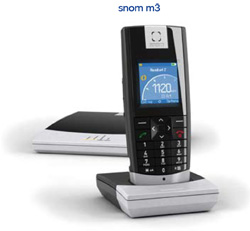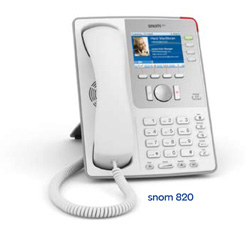|
February 2010 | Volume 13 / Number 2
Cover Story
The Smart Desktop: snom Expands Portfolio, Delivering a Wider Variety of FunctionalityBy: Paula Bernier
Anybody in communications, or for that matter in the general populace, can tell you that, in terms of high tech, 2009 was the year of the smartphone and app store. But there also have been many significant advancements of late on the business desktop device front. Many of them have come from snom technology AG (News - Alert), which recently celebrated the 10-year anniversary of its initial VoIP product launch. INTERNET TELEPHONY recently spoke with Christian Stredicke (News - Alert), founder and CEO of snom, about some of those developments and how, despite 2009 being a down year for the industry, the company continued to move forward – growing in terms of both employees and revenue. What was the original vision for, and first product from, snom? Stredicke: In 1999, we started development of VoIP telephones with the introduction of the snom 100 model, which was initially based on the H.323 protocol. The following year, we added SIP, becoming one of the first SIP handsets. At that time SIP was in its infancy, but we saw the commercial opportunity for a broadly interoperable and highly intelligent SIP endpoint device. We saw from the computer industry that interoperability was going to be crucial, so we were really focused on developing VoIP phones that would be compatible with standards-based platforms from different vendors. While most of the big telecoms were probably laughing at our first handset, we made it into a lot of labs and trials, and through this practically everything that talks SIP was tested against snom phones. So we gained some popularity inside the SIP world, in many respects not for the plastic, but for the software. How has that vision and product portfolio evolved over time? Stredicke: Over the last 10 years, SIP has done a great job establishing interoperability between vendors. I am glad to see that players like Skype (News - Alert) are also beginning to offer SIP interoperability. This makes SIP more valuable than ever, and SIP trunking has become stable and will continue to replace TDM standards. What ISDN could not achieve — establishing a truly global communications standard from residential homes to the backbone – SIP is completing. On the product side, we took the overall physical [appearance] seriously and came out with something that we feel is quite useful and aesthetically pleasing. We also stayed with the original plan to focus on the handsets. There was a lot of temptation to come up with all kinds of other things, but today I am glad we did not get lost in too many projects. It is better to know what your core competency is and stick to it. In the last few months snom has introduced a handful of new products. What do we need to know about them? Stredicke: Last year, we introduced our 800 series desktop phones — the snom 820 and the snom 870 touch screen phone. My original idea [for] the 820 was to make a phone [that] operated off WLAN — without cable Ethernet — which would make it the first phone that fully picks up the idea of the office with no wires. However, our marketing department received clear signals that Ethernet was still in demand, so finally [we] added fixed line Ethernet as well. The 870 added touch screen, which takes user interaction to the next level. We also introduced snom OCS, a special firmware for our 3xx and 8xx series phones for use with Microsoft (News - Alert) Office Communications Server. We are excited about the opportunities that come with OCS and want to help make OCS a reality on the table top, not only on the desktop. We can offer a smooth migration path from purely voice-oriented IP PBX (News - Alert) toward OCS thanks to our multiple registration features of the phones. This is one of those practical concerns that needed to be addressed if real life OCS deployments [were] going to take off. The snom MeetingPoint conference speaker phone was also introduced in 2009, bringing full support of HD voice/wideband VoIP. Customers that already run on snom phones seem to especially like the fact the MeetingPoint shares most of its software with the other phones, making provisioning and interoperability quite simple. With the brand new snom PA1 we are testing [the] waters in the paging market. It is essentially a snom 300 in a small metal casing, so it was not too big a deal from a software development point of view. It makes sense to include the paging feature in the general PBX infrastructure, and with VoIP you can have a lot more control about who and where people are being paged. Combining this with presence information also looks interesting here, moving forward. Imagine that you page in a hospital only to those rooms where required staff are located at any given moment. The latest arrival is the snom m9. With the snom m3, we were not sure if the VoIP community would like DECT (News - Alert). But the m3 was a success, and we decided to take it to the next level. The m9 adds TLS and SRTP, photo caller ID, and other missing features like LLDP and IPv6. The DECT forum is very optimistic about products like the m9, and snom should grab a significant piece of that cake.
Stredicke: The market volume is increasing, and with that comes more variety. A few years ago, customers were probably fine using an analog conference phone with an ATA; today they want SIP right to the end device. We understand what it takes to make a SIP endpoint, and now it the time to use that know-how and come out with new SIP devices and expanded features. How, if at all, do these new snom products parallel trends on the smartphone/mobile front? Stredicke: Well, customers are wondering why practically all cell phones in the market have color displays and the phone on the table is still black and white. That is a valid question, and we addressed it with the display in the new models 820, 870 and also m9. The other common denominator is that the pure voice call has become [a] commodity and the value lies in the applications. You have to offer a lot more than the basic call to make it in the cell phone world, and so is the situation in the SIP desktop phone world. How does what’s happening on the desktop phone front differ from trends around smartphones in mobile? Stredicke: While the common trend is that applications are important, the difference lies in what applications are important. In the cell phone business, many applications are about entertainment. But if we started offering games on our phones our customers would think we had totally gone bananas. An ‘application’ in the office environment can be as boring as seeing if another extension is talking or to browse the corporate address book. It is about getting the job done, quickly. So the applications on a desktop phone may not be as diverse, but need to be very functional. Also keep in mind that cell phones are, obviously, very mobile, so you don’t have your Internet-connected PC next to you when you use the cell phone. If you look at Android (News - Alert), you can see they care little about busy lamp fields, and they care a lot about browser-based applications like finding the next restaurant around you. We have to deal with applications that are made for devices that don’t move, and they are typically in the office.
Stredicke: We considered running software outside of the phones, but in the end, we are talking about a device that is well-connected with at least 10mbps to the outside world. So it seems logical to run components that take a lot of resources outside of the embedded system, but keep the core on the phone. Especially looking at the price of memory these days, it’s easy enough to run the core software locally on the phone. It also makes it easy to switch on the phone and go. I don’t think customers would accept a phone that first has to connect to something outside before becoming operational. But we also offer some features off the phone. For example, we offer a component that can run on your PC — essentially to help you with the dialing process. We also offer an XML-based application interface that can use external servers to render content on the phone's display. There’s been an intersection of IP PBXs and IT communications. How is snom responding? Stredicke: The PBX became a piece of software many years ago. We run our PBX on a server that does a lot of other jobs as well; the PBX software occupies only a small part of the server's capacity and puts it in the realm of IT. That intersection comes very naturally if you run the PBX on a standard server. The same server runs email as well, and it is only logical that the PBX also cooperates with the email server. With all that virtualization, you never know what else is running on that server. As a result, close integration with the PBX becomes more and more important. As the market gets more mature, the VAR is asking for something that can be installed easily, quickly and safely. Those guys who have to install email servers, virus scanners, upgrade operating system and so on, [so] have no time for tricky interoperability problems between the phones and the PBX. They want a solution that just works. Period. This stresses the importance of a close partnership with PBX vendors for us that goes beyond simple basic interoperability.
Stredicke: Bandwidth is increasing, and in a few years we will have so much that it will sound crazy to run something simple like a voice server locally, on a customer premises. However, my biggest concern is QoS, even when there is a lot of bandwidth available. A big difference between TDM and VoIP is that VoIP needs to report if the voice actually made it. If you can't measure QoS, you can't fix it. And you can't charge for it. The endpoint must be involved here; other devices like SBCs have no way to measure the actual packet arrival at the device on the table. Talking about functionality, the difference between running CPE-based services and services managed by specialists is that the hosted software can be maintained on [a] daily basis. This leaves a lot of room for new applications that you would never care about if you [had] to pay your system administrator to install them. Those applications might be focused on the customer’s business, and therefore be mission-critical. Think about the dentist IVR application that informs about [the] latest trends in oral surgery or the shop chain central IVR that links the Web presence with the local outlet phones. Your company is a proponent of wideband audio, aka HD voice. Why? Stredicke: Voice is still the most important application on VoIP phones. Anything that improves the overall audio quality of VoIP, and allowing this technology to reach its full potential, is something we heartily endorse. snom’s KLARvoice, our wideband technology name, supports various modern codecs as well as the good old G.722 codec and makes the normal audio of a phone conversation a better experience. How will the rise of HD voice benefit snom? Stredicke: Value will translate into revenues. Put it this way, it is a competitive feature. Those who don’t offer it will lose business. Those who offer it will pick up this business. snom wants to be in the latter group.
Stredicke: It is simple. We will continue to lead in this category and develop new generations of SIP firmware for new and existing ecosystems of applications and technology partners. What is snom’s go-to-market strategy? Stredicke: In the U.S., we work with VARs and resellers and through our network of distributors. We also work with a broad set of IP communications partners — IP PBX, open source PBX, hosted and managed voice and Internet service providers. What are snom’s expectations for 2010? Stredicke: We expect nothing less than doubling our growth. Maybe a few new competitors will try to enter the VoIP handset market, but they will burn some cash and burn their fingers on the complexity they will face there. Projects that have been postponed in 2009 will be reactivated and then customers will look for products that have shown that they fulfill the requirements. IT Today @ TMC
Headlines
Upcoming Events
MSPWorld
The World's Premier Managed Services and Cloud Computing Event Click for Dates and Locations Corporate News
|
|





 Why is snom introducing these particular products now?
Why is snom introducing these particular products now? All of snom’s software exists in the firmware on the phones. Why is that meaningful?
All of snom’s software exists in the firmware on the phones. Why is that meaningful? Cloud-based services are based on the concept of taking equipment off customers’ premises and instead putting services and smarts within networks. Meanwhile, snom is focused on bringing more functionality to the desktop. How, if at all, is snom changing the way it thinks about communications in light of the cloud phenomenon?
Cloud-based services are based on the concept of taking equipment off customers’ premises and instead putting services and smarts within networks. Meanwhile, snom is focused on bringing more functionality to the desktop. How, if at all, is snom changing the way it thinks about communications in light of the cloud phenomenon? Integration and interoperability are always important topics in communications. What is snom’s strategy on these fronts?
Integration and interoperability are always important topics in communications. What is snom’s strategy on these fronts?
